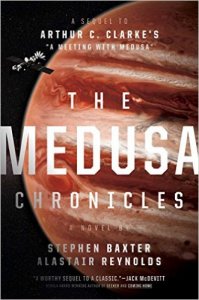Paul Di Filippo reviews Stephen Baxter & Alastair Reynolds
The Medusa Chronicles, by Stephen Baxter and Alastair Reynolds (Gollancz 978-1473210189, £16.99, 336pp, hardcover) May 2016 (Saga 978-1481479677, $26.99, 416pp, hardcover) June 2016
 This is not the first time Stephen Baxter has collaborated with Arthur C. Clarke. The Light of Other Days came out in the year 2000, and the three volumes in the Time Odyssey sequence also all appeared while Clarke was still alive (he died in 2008). How much the senior author contributed to each project will forever remain unknown to everyone but the younger partner. Nonetheless, Baxter always showed himself fully in tune with the modes, motives, means and missions of Clarke, evidently to Clarke’s full approval. So this posthumous joint venture—or “sequel by other hands,” if you will—where Clarke can have contributed only the basic starting point, can still be reliably counted on, I think, to honor the original inspirational novella—“A Meeting with Medusa,” written in 1971 when Clarke was at his prime.
This is not the first time Stephen Baxter has collaborated with Arthur C. Clarke. The Light of Other Days came out in the year 2000, and the three volumes in the Time Odyssey sequence also all appeared while Clarke was still alive (he died in 2008). How much the senior author contributed to each project will forever remain unknown to everyone but the younger partner. Nonetheless, Baxter always showed himself fully in tune with the modes, motives, means and missions of Clarke, evidently to Clarke’s full approval. So this posthumous joint venture—or “sequel by other hands,” if you will—where Clarke can have contributed only the basic starting point, can still be reliably counted on, I think, to honor the original inspirational novella—“A Meeting with Medusa,” written in 1971 when Clarke was at his prime.
Now, add in the talents of New Space Opera UK Superstar Alastair Reynolds, and the resulting book should be a right treat. And so it proves to be. A semi-Stapledonian history of our intelligence-haunted solar system.
The first thing I should mention about this review is that I have not gone back and re-read Clarke’s original launchpad story, especially since the current authors provide a handy synopsis of it in the front of the new book. I don’t think one needs to, to enjoy the new production. And the second thing to note is that the voice of The Medusa Chronicles is utterly organic and seamless, a blend of Baxter’s and Reynolds’ distinct styles which emulates Clarke’s to a high degree, without affectations or pastiche.
Our hero is Howard Falcon, the first man to have seen the native inhabitants of Jupiter, the medusae. Restored after an accident to the condition of a cyborg, Falcon is indeed civilization’s only man-machine hybrid, what with popular opinion and legislation having come down against such fusions. That status will leave Falcon in a liminal condition that makes him the perfect ambassador from humanity to its heirs, as we shall see.
The book opens just a few years after the incidents of the Clarke story. We get acquainted with the political and technocratic players of the era, including the “simps,” uplifted simians. There’s a suspenseful incident of terrorism. We also learn in subtle fashion that this is a counterfactual timeline to ours (an RFK presidency, for instance); necessarily so, I think, to accommodate the 1971 ancestry of the story. Then, with the narrative parameters in place, we begin hopscotching across the centuries. For Falcon’s condition has rendered him more or less immortal, transforming him into “a calm, passionless witness to centuries rolling like tides across the solar system.”
It would be indiscreet of me to reveal all the surprises Reynolds and Baxter have in store for the reader, so I will just outline them broadly. First, they depict a fully inhabited solar system, where mankind has established beachheads from Mercury to the Kuiper Belt. Then they take Falcon out to the Oort Cloud, where he is instrumental in the birth of true artificial intelligence. (Like Ultron and Hank Pym, the son and father relationship gets a lot of resonant play.) These silicon intellects, dubbed simply the Machines, will become humanity’s competitors and doom-bringers. We next follow Falcon back to Jupiter, where he uncovers Martian skullduggery. At this point is issued the Jupiter Ultimatum by the Machines, involving the fate of Earth five centuries hence. Falcon takes a trip to Mercury for a vital last-ditch campaign against the Machines. In the twenty-sixth century we witness the demise of the home planet.
Several decades pass, with humans dispersed into niches around the solar system. A faction intent on getting revenge against the Machines approaches Falcon for the role of intermediary. Again, he descends into Jupiter’s atmosphere. But will this prove to be his final mortal mission?
The authors exhibit all the speculative brilliance for which they are individually known. Their conceits range all the way from the kind of flaring eruptions of cosmic energies that would have been familiar to Doc Smith to quantum-based technologies at the cutting-edge of today’s physics. Logic viruses that spread through entanglement? Now that’s sense of wonder! Their language is always precise and transparent, allowing the reader to grok what’s happening. And their characters, while not Flaubertian in depth, achieve enough solidity and capaciousness to hold our sympathies and vibrate thrillingly under the dramatic circumstances of their lives.
The quasi-mystical cascade of epiphanies that close out the book echoes Clarke’s 2001 climax in a satisfying manner, as well as some elements of Childhood’s End. I would also adduce Greg Benford’s Galactic Center Saga as a model for this well-stuffed novel.
With this book, Baxter and Reynolds honor Clarke’s legacy at the same time as they point the way forward for the continuation of Clarke’s brand of optimistic SF which is no mere wish-fulfillment “competence porn” but also a clear-sighted depiction of both the virtues and vices of our species.





